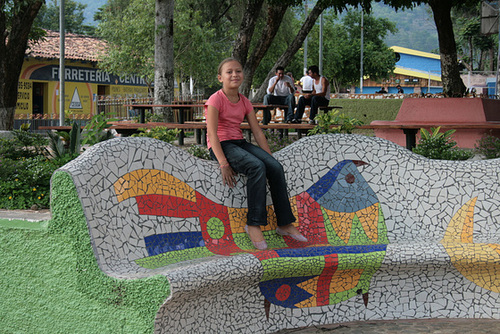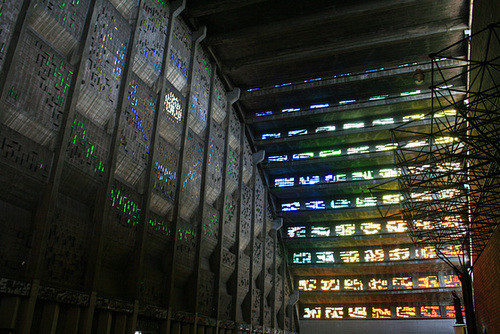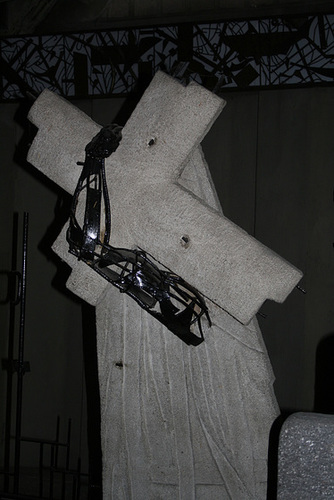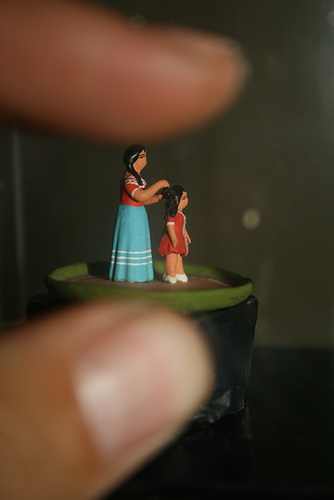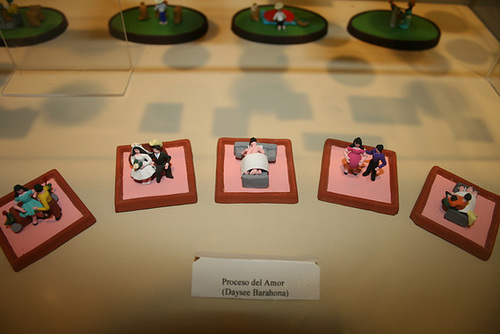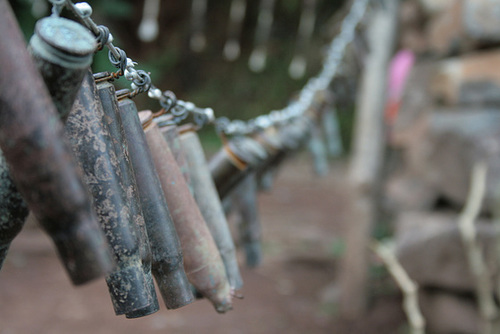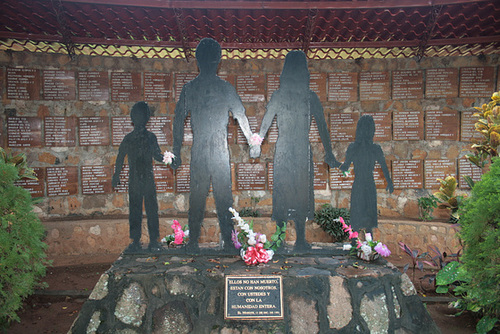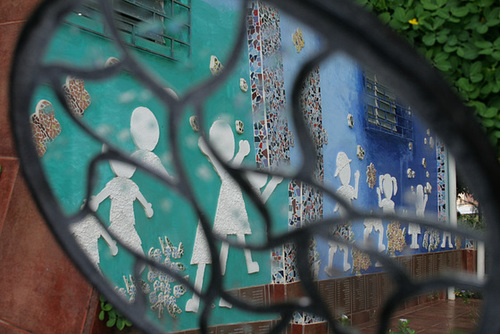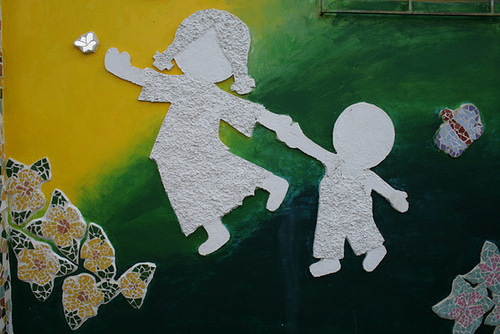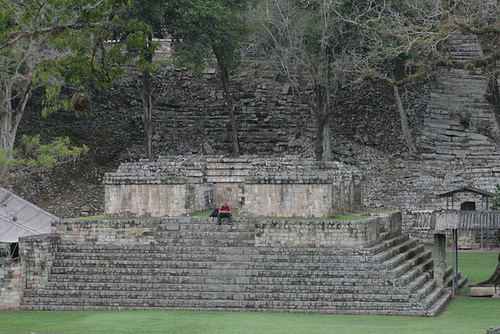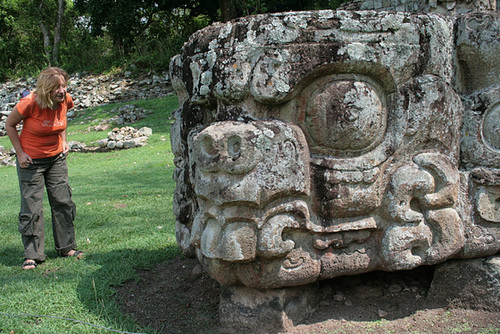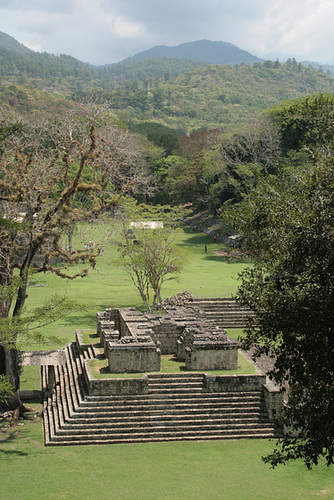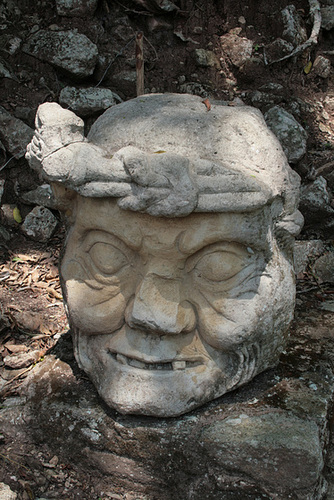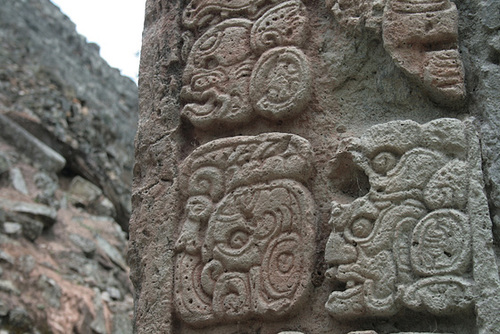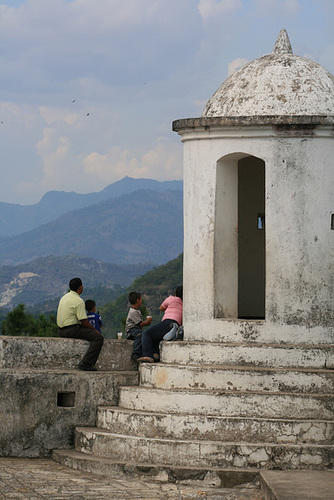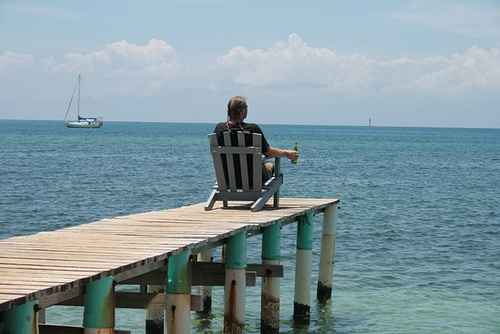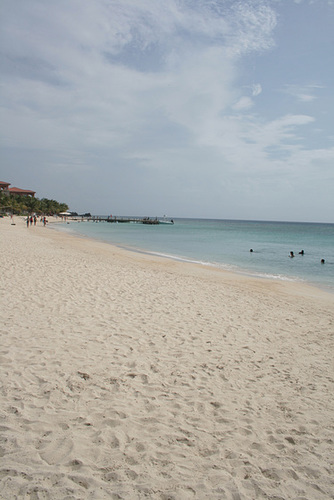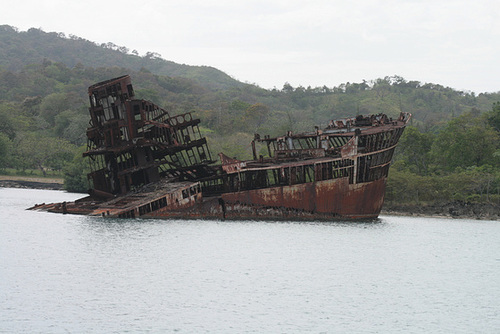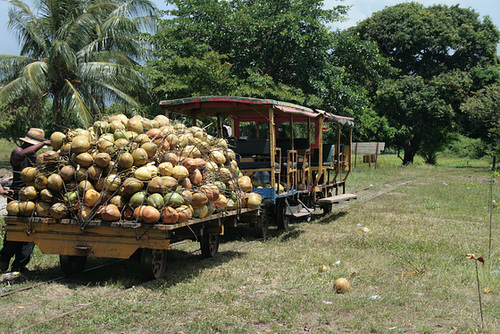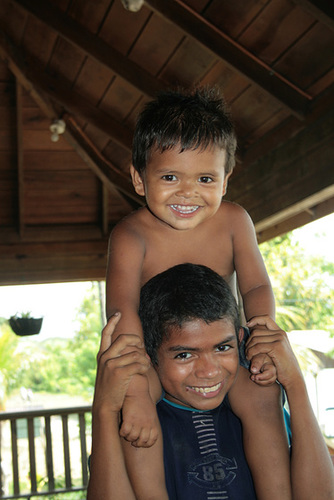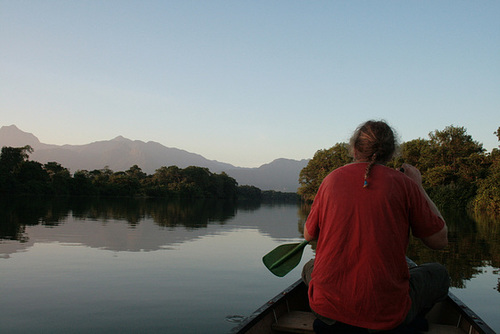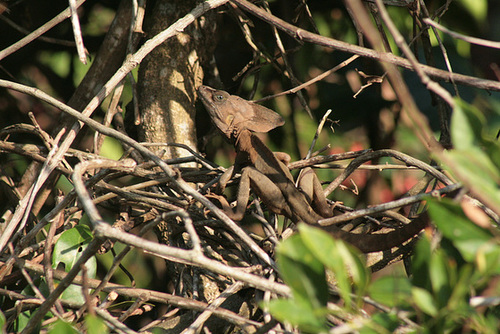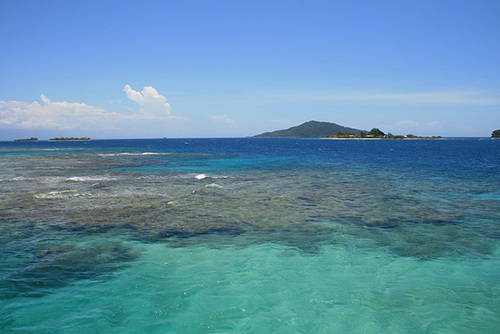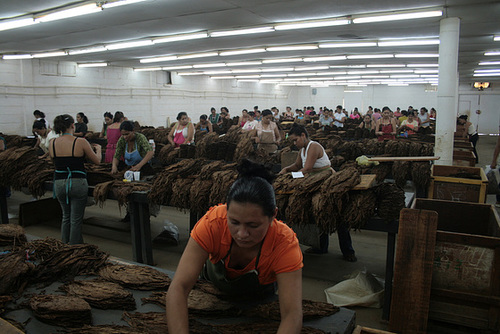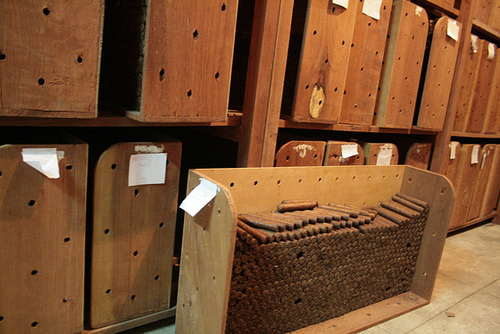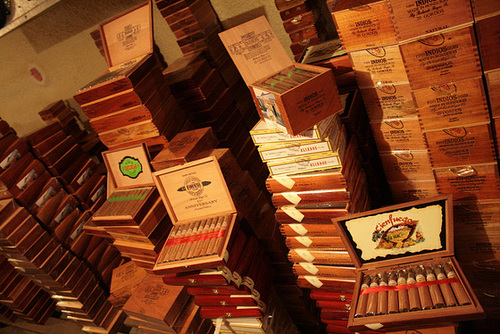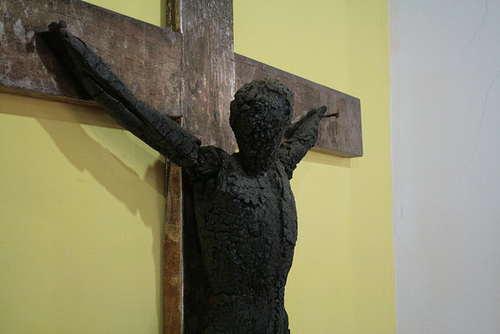22 to 28 May, 2009 – Suchitoto (and Los Tercios), Juayúa, Ataco, and Tacuba (Parque Nacional El Imposible)
Suchitoto. We debated coming or skipping. Not too much of a diversion, but a vague reference to a weekend market, along with an interesting waterfall, backed up with a recommendation from our very good friends Ombi and Alex, and we found ourselves there. The town was very nice :D The market was quite disappointing :( And the waterfall was beautiful, despite lacking an important ingredient – water!
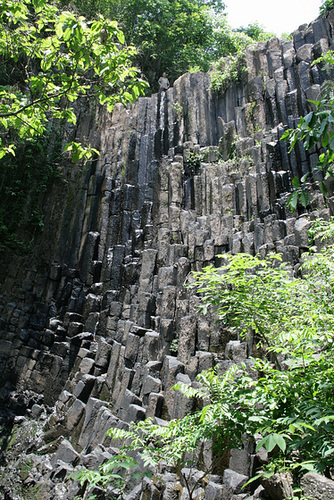
Columned Waterfall
OK, so the water is almost impossible to see. In fact, most of the time, this waterfall has very little water. A sort-of waterlessfall. But we were there for the basalt columned cliffs that are exposed beneath the falls, and they were quite beautiful. Oh, btw, that IS me up the top there.

Top Of The Waterfall
This angle highlights two things. Firstly, seeing the tops of the columns, it gives an idea of the size and shapes of the basalt formations. Secondly, it highlights how small the dribble of water actually was!
Maybe if it had been close to easter, we might have had some idea about the following...

Multi-Coloured Chickens
This was on a bus. And yes, they do get nicknamed "chicken buses" because of the frequency that people will travel on the carrying chickens. But this was a first for us. When she got on the bus with a crate, I could tell they were chickens, but was sure I caught a glimpse of green through an opening. When she put them down, we couldn't stop laughing at the fluorescent chicks! We never found out why...
No time to stop. After spending Saturday at the disappointing weekend market at Suchitoto, we headed straight through San Salvador to Juayúa in the western part of the country. All indications were that this was the market to get to. And not for the regular market products, or the tourist market merchandise, but the food!
A gastronomy festival! Dozens of stalls greeted us. Apprehensively, we started scanning, expecting to see two or three dishes repeated dozens of times. But no, we had so much choice. Too much choice! Why didn't we get here yesterday? We would have had more meal times to try more food. Predictably, we went for seafood options. After eating (and drinking and eating some more), we enjoyed the entertainment – a singer of extraordinary talent and humour. Unfortunately, he didn't have any cds with him that we could buy. After all that eating, there was only one thing we could face – collapsing in our room for a couple of hours. And then it was time to hit the food stalls again! Except, they were closing up early on Sunday evening. Which was a real pity, as I was truly thinking about trying some grilled frog for dinner.
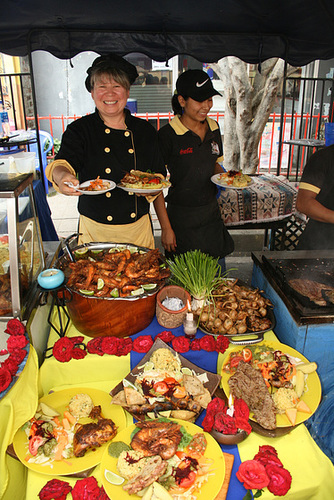
"Food Glorious Food"
One stall showing a sample of the food on offer at the weekend gastronomy market in Juayúa. We did go a bit crazy!

Ensuring We Get Our Fruit
Sometimes we find that we eat a lot of things that taste good but aren't necessarily so good for us. So we need to be disciplined and ensure we eat our fruit. Oh, chocolate and nuts on our strawberries? I don't know what THEY were doing there!
So, Monday was our chance to walk some of all that food. Off to some waterfalls.

Waterfall Near Juayúa
One of a number of waterfalls near Juayúa.

Another Waterfall Near Juayúa
One of a number of waterfalls near Juayúa.
Tuesday, via Ataco ...

Mural In Ataco
Brightly decorated building in the mountain village of Ataco.
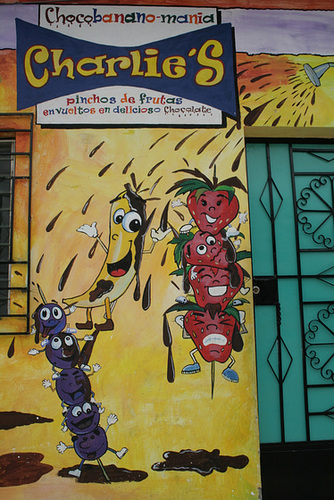
"Pinchos de Frutas" Shop in Ataco
Cute mural on a shopfront, Ataco.
... to Tacuba.

Parque Nacional El Imposible
One of the vistas on our walk.
El Imposible. So named because of the gorge that cuts through it. Once upon a time, locals transported coffee across the gorge with mules, using fallen trees to span the gap. Many lives were lost (human and mule). In 1968 a bridge was built. The reputation was lost, but the name remained.
Suchitoto. We debated coming or skipping. Not too much of a diversion, but a vague reference to a weekend market, along with an interesting waterfall, backed up with a recommendation from our very good friends Ombi and Alex, and we found ourselves there. The town was very nice :D The market was quite disappointing :( And the waterfall was beautiful, despite lacking an important ingredient – water!

Columned Waterfall
OK, so the water is almost impossible to see. In fact, most of the time, this waterfall has very little water. A sort-of waterlessfall. But we were there for the basalt columned cliffs that are exposed beneath the falls, and they were quite beautiful. Oh, btw, that IS me up the top there.

Top Of The Waterfall
This angle highlights two things. Firstly, seeing the tops of the columns, it gives an idea of the size and shapes of the basalt formations. Secondly, it highlights how small the dribble of water actually was!
Maybe if it had been close to easter, we might have had some idea about the following...

Multi-Coloured Chickens
This was on a bus. And yes, they do get nicknamed "chicken buses" because of the frequency that people will travel on the carrying chickens. But this was a first for us. When she got on the bus with a crate, I could tell they were chickens, but was sure I caught a glimpse of green through an opening. When she put them down, we couldn't stop laughing at the fluorescent chicks! We never found out why...
No time to stop. After spending Saturday at the disappointing weekend market at Suchitoto, we headed straight through San Salvador to Juayúa in the western part of the country. All indications were that this was the market to get to. And not for the regular market products, or the tourist market merchandise, but the food!
A gastronomy festival! Dozens of stalls greeted us. Apprehensively, we started scanning, expecting to see two or three dishes repeated dozens of times. But no, we had so much choice. Too much choice! Why didn't we get here yesterday? We would have had more meal times to try more food. Predictably, we went for seafood options. After eating (and drinking and eating some more), we enjoyed the entertainment – a singer of extraordinary talent and humour. Unfortunately, he didn't have any cds with him that we could buy. After all that eating, there was only one thing we could face – collapsing in our room for a couple of hours. And then it was time to hit the food stalls again! Except, they were closing up early on Sunday evening. Which was a real pity, as I was truly thinking about trying some grilled frog for dinner.

"Food Glorious Food"
One stall showing a sample of the food on offer at the weekend gastronomy market in Juayúa. We did go a bit crazy!

Ensuring We Get Our Fruit
Sometimes we find that we eat a lot of things that taste good but aren't necessarily so good for us. So we need to be disciplined and ensure we eat our fruit. Oh, chocolate and nuts on our strawberries? I don't know what THEY were doing there!
So, Monday was our chance to walk some of all that food. Off to some waterfalls.

Waterfall Near Juayúa
One of a number of waterfalls near Juayúa.

Another Waterfall Near Juayúa
One of a number of waterfalls near Juayúa.
Tuesday, via Ataco ...

Mural In Ataco
Brightly decorated building in the mountain village of Ataco.

"Pinchos de Frutas" Shop in Ataco
Cute mural on a shopfront, Ataco.
... to Tacuba.

Parque Nacional El Imposible
One of the vistas on our walk.
El Imposible. So named because of the gorge that cuts through it. Once upon a time, locals transported coffee across the gorge with mules, using fallen trees to span the gap. Many lives were lost (human and mule). In 1968 a bridge was built. The reputation was lost, but the name remained.


